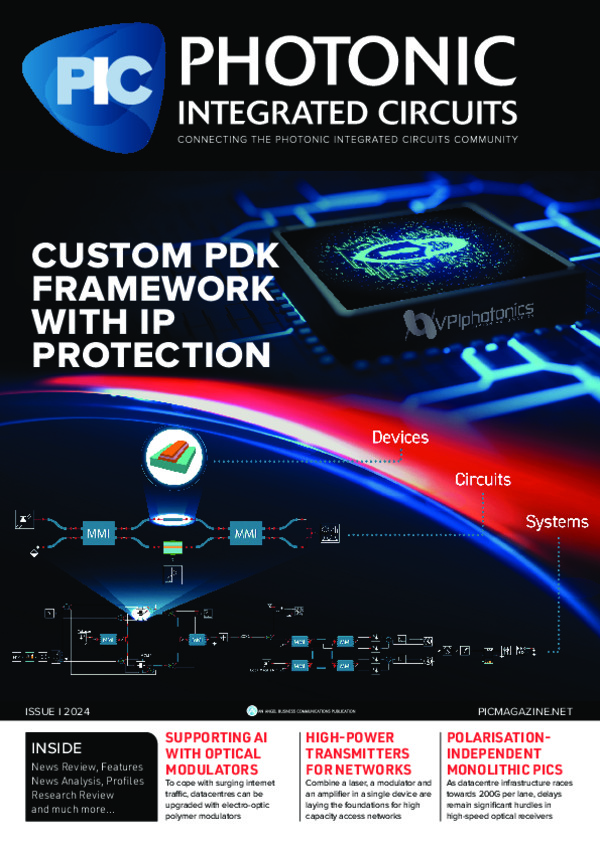
Supporting AI with new optical modulators

To cope with surging internet traffic, datacentres can be upgraded with electro-optic polymer modulators. This technology requires no changes to the rest of the infrastructure and has performance headroom to support continual upgrades for decades.
By Michael Lebby, Chief Executive Officer, Lightwave Logic
There has long been talk of AI’s transformative potential, and the last year has made it clearer than ever that the AI revolution has begun. The technology is already reshaping many aspects of our daily lives as end users. But behind the scenes, AI is also impacting the industries and infrastructure that play a role in providing access to it. And photonics is no exception.
To understand how this trend might affect photonic integrated circuits (PICs), we must first consider how AI relates to the internet and optical networks. Although we would all like to see optical computing, and optical computational processing, this holy grail has yet to become widely commercialised like semiconductor microprocessing units (MPUs) or graphical processing units (GPUs).
Datacentres need to upgrade to meet the unabating demand for higher data rates.
For this reason, the industry currently uses photonics to send the information from MPUs and GPUs from source to destination, with fibre optic cables that form the architecture of the internet and optical network.
At the highest level, electronics does the computational processing, and is expected to continue doing so in the near future, while photonics helps convey huge amounts of generated information optically.
The photonic components that make up the communication are laser diodes, modulators, and photodetectors. These components are now becoming integrated into PICs, typically with one PIC transmitting data, and another receiving it. PICs are found in transceiver modules, which, in turn, are found in the switches and router equipment that make up a datacentre.
As surging AI usage demands higher data rates, PICs are therefore one piece of the puzzle in upgrading datacentres to meet that demand. As well as looking at the challenges posed by AI, this article describes how electro-optic polymers are driving new hybrid technologies for increased PIC performance.
High EO S21 RF bandwidth measurement of an electro-optic polymer modulator with approximate comparisons of other materials.
Skyrocketing data rates
It is widely expected that AI will substantially increase the bandwidth required to operate the internet at the speed users have come to expect. This is because AI users are increasingly experimenting with innovative ways to drive new applications which require large amounts data to be synchronously exchanged between switches and users.
In the 1980s, it would typically take tens of minutes to download a 10 Mb file, but this can be done today in less than a second. Videos were virtually impossible to download and send around back then, but today we share short video clips, even movies, with friends and family regularly. Thanks to these advances, images and videos have become the largest generators of internet traffic. But it now seems likely that AI will surpass them. Whereas it took Netflix 3.5 years to get to one million subscribers, it took ChatGPT just five days to reach the same milestone.
Additionally, over the past 60 years, computing power in high computational processing systems has skyrocketed. Its growth initially doubled every 3-5 years [1], and, since about 2020, it has increased by over an order of magnitude, to a doubling of computational power every 3-4 months in terms of petaflops [2]. Naturally, this puts strain on the infrastructure supporting it.
All parts of the network need to cope with increased quantities of information, from the fibres that optical signals travel down to the places performing optical routing and switching – which typically happens in datacentres. The financial cost for internet and optical network operators will be substantial. Further, it is not only the increased performance of sending information through the optical network that needs attention, but also ensuring power consumption is kept at reasonable levels, as data rates increase.
4-channel 200G PAM4 1310 nm PIC design using electro-optic polymers.
Datacentres and the internet
As AI becomes increasingly integrated within our daily activities, we are already seeing datacentres being upgraded today in a fashion that the industry has not seen before. This feels reminiscent of the internet bubble of 2000.
As we are in a growth stage, we don’t yet know if the trend is bubble-like. However, it is worth noting that the markets for the internet bubble collapsed largely due to poor growth and business. What is different today is that we are seeing datacentre companies already investing to update their equipment with solid, committed capital expenditure. This effect looks to be stronger than in 2000 and could drive robust growth for electronic computational processing chips and photonic chips over the next decade.
What is interesting from a photonics standpoint is that datacentre operators have pretty much ignored the photonics node of 400G and are focusing on 800G and 1.6T (or 1600G). Just two years ago, every market analyst covering datacentres, and more specifically optical transceivers, was forecasting huge growth in 400G with optical transceivers as the main vehicle. Datacentres were looking at 4-channel 100G and 8-channel 50G as key solutions for aggregation into 400G. Today, this has all changed; forecasts for 400G are flat if not declining, and the focus is on 800G.
Unfortunately, the industry is not ready for 4 lanes at 200G, so initial prototypes demonstrated at major industry trade shows in 2023 are implementing 800G as best they can: using 8 channels with 100G lanes. However, the move towards 200G lanes is accelerating, pulled along by the excitement around AI, and by datacentre operators’ motivation to upgrade equipment as quickly as possible. Simply creating a 4-channel 200G-lane optical transceiver is not easy. Many in the industry are now realising that the photonics need to upgrade also, and 20-30 GHz optical 3 dB bandwidth modulators for the transmitter PIC are too slow.
In general, optical modulators are components that switch and modulate light, and there are millions of them embedded in the internet. However, the higher data rates necessitated by increasing AI usage are pushing incumbent semiconductor solutions to their limits. This has led the industry to look for faster optical modulators that have 3 dB optical bandwidths double or triple the bandwidths of today’s solutions (silicon, indium phosphide, lithium niobate).
Further, optical transceivers need to rein in their power consumption. While the majority of power is consumed by the electronics, there are still significant savings to be made through more efficient use of PICs. Lastly, another major factor for optical transceivers is size or footprint; as transceiver sizes are shrinking, smaller-footprint photonics is key.
These requirements of higher speed, lower power, and smaller size create big challenges for both the electronics and photonics industries. The electronics industry is addressing this via linear pluggable optics (LPO) to reduce power consumption. Meanwhile, the photonics industry is turning to innovative optical modulator technology for PICs.
One promising solution is electro-optic polymers, which offer a hybrid solution, as the material is organic and can be spun or dropped onto an existing PIC platform made of silicon or another material. The polymers are physically positioned in front of lasers that are also part of the PIC. Excitingly, electro-optic polymers significantly outperform semiconductor technologies being used in the internet today. With optical 3 dB bandwidths exceeding 100 GHz, and that have been measured to over 250 GHz, electro-optic polymers are well positioned to enable 800G, 1.6T, 3.2T and even higher speeds over the next decade.
Additionally, with drive voltages in the sub 2 V that range down to the 0.5 V level, this technology minimises power consumption effectively. And finally, with electro-optic modulator device structures such as the slot, footprint sizes are extremely tiny, and can therefore work with many different form factors for optical transceivers, within both pluggable design as well as co-packaged, on-board optics design.
Lightwave Logic’s electro-optic polymers
Lightwave Logic [3] has been pursuing this potential of electro-optic polymers to replace existing modulators, using its patented Perkinamine molecular compounds – state-of-the-art organic materials that can be used to create the polymers. The company starts with its proprietary organic chromophores, which are a key ingredient of polymers, and deposits them onto a silicon chip to add an optical modulator function.
During fabrication, the polymers are aligned through brief application of a high voltage, enabling ultra-fast modulation at ultra-low power. Both the polymer materials and the silicon PICs they are incorporated into perform stably and reliably, meaning they are well positioned to displace current semiconductor technologies.
The silicon-based chips used are about a few millimetres on each side, and they act as the engine of a fibre optic transceiver, which is a core component of switches and routers in datacentres. One of the advantages of using polymer modulators can be understood through the analogy of automotive vehicles; using these modulators is akin to upgrading a car simply by replacing its engine with a better one, while keeping the rest of the structure the same. Similarly, polymer modulators can improve the fibre optic modules, while leaving other parts of the datacentre infrastructure as they are.
Thanks to velocity-phase matching of the electrical signal and the optical beam, electro-optic polymers have inherently high performance, and, crucially, the potential for this to increase even further in later-generation products. Technology with this performance headroom is essential to support the continual upgrading that the internet and optical networks need. Conversely, competing technologies – both those that are incumbent and those competing for new business – may not work well beyond the maturation of the current generation of technology.
One way to visualise this performance potential is to consider the same baseline of 3 dB optical bandwidth in each modulator. Over the past 10 years, semiconductor modulators have generally been achieving around 20-30 GHz, but recent enhancements to both silicon and indium phosphide designs have raised their performance to 40-50 GHz, occasionally approaching 60 GHz. In general, to achieve 100G (or 100 Gbaud NRZ) and 200G (or 100 Gbaud PAM4) encoding, a 70 GHz 3 dB optical bandwidth is required.
Today, many datacentre operators are seeking technologies that can achieve 200G per lane. Since polymer modulators can reach 70 GHz, and even 150 GHz – about double current lane rates – they could pave the way for 1.6T with 4 lanes at 400G. Moreover, when enhanced with plasmonic designs, modulator devices using Lightwave Logic’s electro-optic polymer material have exhibited 3 dB bandwidths exceeding 250 GHz.
Polymer modulators for AI
It is the potential performance of new technologies in photonics that will enable datacentre operators to navigate the demands of AI. Further, a new technology platform that can turbo-boost existing transceivers without changing the network architecture and infrastructure is a low-cost approach to speed up the internet, keep power consumption at bay, and keep the footprint and size the same.
The potential for Lightwave Logic’s polymer technology to make datacentre operators more competitive with their equipment upgrades has never been higher. As AI changes our lives, we face grand challenges ahead, but we have the motivation to utilise our toolkits to meet those challenges. I’m sure this will involve developing numerous new technologies, but electro-optic polymers are certainly an excellent candidate to move the needle forward for all of us.
Further reading
• [1] OpenAI, The Economist, Data Center World, “Computing power used in training AI systems”
• [2] https://datacenters.lbl.gov/sites/default/files/ Masanet_et_al_Science_2020.full_.pdf
• [3] https://www.lightwavelogic.com



































